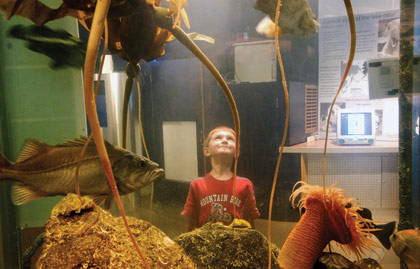The Partnership for Interdisciplinary Studies of Coastal Oceans (PISCO) is a long-term program of scientific research and training dedicated to advancing the understanding of the California Current Large Marine Ecosystem along the U. S. west coast. PISCO conducts monitoring and experiments along 1,200 miles of coastline incorporating oceanography, ecology, chemistry, physiology, molecular biology, genetics, and mathematical modeling to gain novel insights that apply to conservation and resource management issues. The program is led by OSU marine biologist and new head of NOAA, Dr. Jane Lubchenco, and involves scientists at OSU, Stanford, UC Santa Cruz and UC Santa Barbara who lead local, regional, national and international initiatives for marine environmental planning. Since 2005, core funding has been provided by The David and Lucille Packard Foundation and the Gordon and Betty Moore Foundation.
The program focuses on three important ecosystem components: rocky shores, coastal currents, and kelp forests. PISCO’s data on kelp forests are online for the world to see. New interactive maps on the PISCO Web site enable users to explore several years of data on fishes, invertebrates, and algae. Web visitors can select a species and see PISCO’s monitoring data on the species’ abundance, size, and geographic distribution at sites along California’s southern and central coasts. The site includes photos, video, and description of the research methods. The maps are linked directly to the PISCO database, so they automatically display the most up-to-date information.
www. pisco.org/data


 On my first visit to the California Academy of Sciences in San Francisco, I saw whales, volcanoes and dinosaurs. I visited planets and stars and saw a giant pendulum swinging from the ceiling, knocking over a circle of sticks, one stick at a time. Evidence of the Earth’s rotation, so someone said. I thought it was a trick because nothing was rotating from my perspective. But then I was probably five years old.
On my first visit to the California Academy of Sciences in San Francisco, I saw whales, volcanoes and dinosaurs. I visited planets and stars and saw a giant pendulum swinging from the ceiling, knocking over a circle of sticks, one stick at a time. Evidence of the Earth’s rotation, so someone said. I thought it was a trick because nothing was rotating from my perspective. But then I was probably five years old. The College of Science Fellows Fund helps us to recruit the best and brightest graduate students who go on to become leaders in their field. There are benefits for faculty and undergraduates, too.
The College of Science Fellows Fund helps us to recruit the best and brightest graduate students who go on to become leaders in their field. There are benefits for faculty and undergraduates, too. 